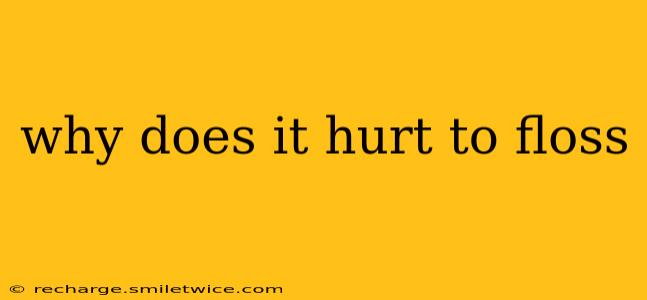Flossing is crucial for maintaining good oral health, yet many people avoid it because it hurts. This discomfort isn't necessarily normal, and understanding its causes can help you transition to a pain-free flossing routine. This article will explore the various reasons why flossing might be painful and offer solutions to make the process more comfortable.
Why Does Flossing Hurt? Common Causes and Solutions
Several factors contribute to the pain associated with flossing. Let's delve into the most frequent culprits:
1. Gum Inflammation (Gingivitis):
This is the most common reason for flossing pain. Gingivitis, the early stage of gum disease, causes inflammation and bleeding gums. When you floss inflamed gums, the floss irritates the sensitive tissues, leading to discomfort.
Solution: Gentle flossing is key. Don't force the floss between your teeth. Instead, use a slow, careful motion. Regular brushing and flossing, combined with professional cleanings, will help reduce gum inflammation and make flossing less painful over time. Consider using a fluoride mouthwash to further reduce inflammation.
2. Improper Flossing Technique:
Using the floss incorrectly can also cause pain. Snapping the floss between teeth, using too much force, or not curving the floss around each tooth can irritate the gums and cause bleeding.
Solution: Learn the proper flossing technique. Gently guide the floss between your teeth using a C-shape around each tooth. Avoid snapping the floss, as this can damage your gums. There are plenty of videos and tutorials online demonstrating the correct method.
3. Plaque Buildup:
Excessive plaque buildup along the gum line can make flossing painful. The plaque irritates the gums, creating sensitivity and making the area more prone to bleeding when flossed.
Solution: Regular flossing is essential for preventing plaque buildup. Aim to floss at least once a day. Consistent flossing, along with brushing, will help reduce plaque accumulation and lessen the pain over time.
4. Receding Gums:
Receding gums expose the roots of your teeth, which are more sensitive than the enamel-covered crowns. Flossing can irritate these exposed roots, causing pain and discomfort.
Solution: If you have receding gums, talk to your dentist or periodontist. They can recommend specialized flossing techniques or tools, such as interdental brushes, that might be more comfortable and effective for cleaning around your teeth.
5. Newly Aligned Teeth (After Orthodontic Treatment):
After orthodontic treatment, your teeth may be slightly sensitive as they settle into their new positions. Flossing can aggravate this sensitivity temporarily.
Solution: Be gentle when flossing and consider using a fluoride mouthwash to help soothe your gums. The sensitivity should decrease over time as your teeth and gums adjust.
6. Using the Wrong Type of Floss:
Some floss materials might be too abrasive or not suited for your teeth and gums. This can also be a contributor to pain.
Solution: Experiment with different types of floss – waxed, unwaxed, flavored, or even floss picks – to find one that is more comfortable for your teeth and gums.
When to See a Dentist
While some initial discomfort is possible, persistent pain or bleeding while flossing warrants a visit to your dentist. They can identify the underlying cause and recommend appropriate treatment, which might include addressing gum disease or providing guidance on improving flossing technique. Ignoring consistent flossing pain could lead to more serious oral health problems.
Making Flossing a Pain-Free Habit
Transitioning to pain-free flossing takes time and patience. Start slowly, use the right technique, and be gentle with your gums. Over time, as your gums heal and you establish a consistent flossing routine, the process will become less painful and more comfortable. Remember, the benefits of flossing significantly outweigh the initial discomfort. Good oral hygiene is crucial for overall health.
